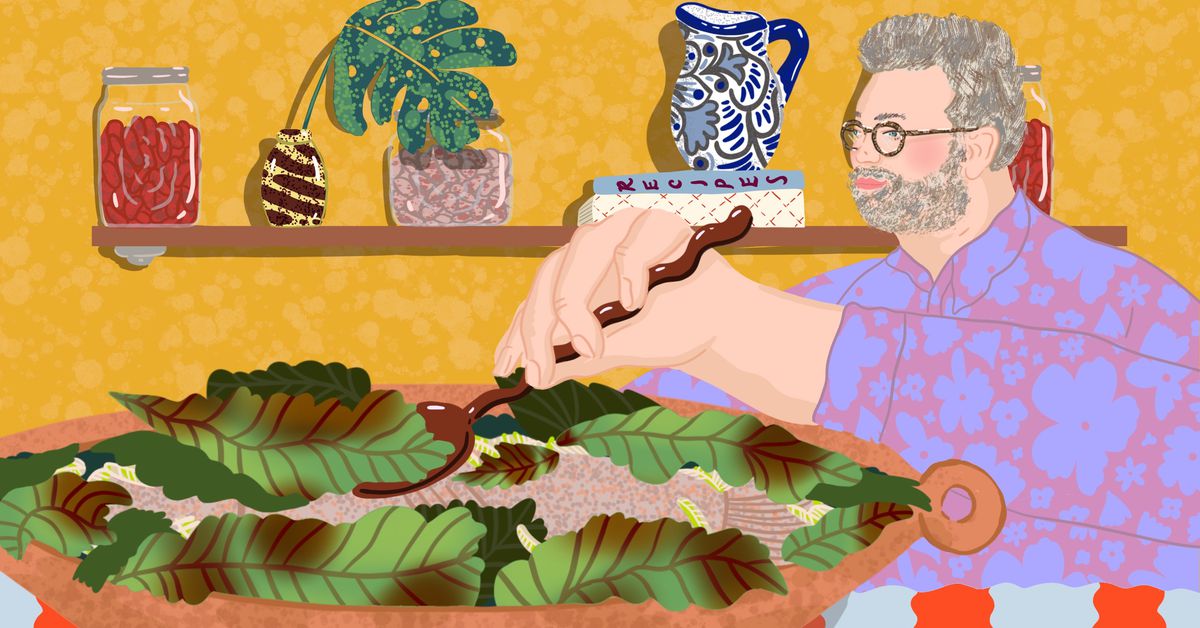
We all could use a little dinner inspiration — even Ali Slagle, who dreams of dinner. In “Dinner Is Served,” she asks colleagues about one night when they somehow transformed ingredients into dinner with all this life going on.
This month’s installment: Steve Sando and his company Rancho Gordo have been supplying and promoting heirloom beans and grains from Napa Valley for over 20 years, but during the pandemic, bean freaks proliferated and his sales skyrocketed. His subscription bean club has swelled to 20,000 members, with a waitlist (it’s now the shortest it’s been in a long while…if you want to sign up).
So often my cooking is a race to use up stuff that’s about to go. I think food waste is really sinful and so I really try to not waste anything. Last night I had nuts and cheese for dinner, and the night before that I also wasn’t really in the mood to cook, but I had trout that I got at the farmers market that I had to use.
I love fish, but I’m the worst person to cook it because every time it’s either undercooked or totally dried out. I salted and olive oiled the filets about an hour before it was time to cook and I got out my tagra. It’s a Moroccan clay roaster, an open cazuela-type thing, that’s meant for roasting fish in particular. Then I said “oh, my fig tree is doing really well,” so I lined the targa with the fig leaves. With my mandolin, I shaved onion and fennel and tossed those with olive oil and salt. Then I put those down in the tagra and put the trout on top of that. I covered it again with the fig leaves. This took five minutes. Well, maybe a bit longer.
And then the tagra fit in my toaster oven! I baked that at 350 degrees for 20 minutes. It’s really cool because the smell of the fig leaves is almost like vanilla and cinnamon and something else that you can’t identify. The fig leaves also make [cooking fish] more forgiving. I actually also put on herbes de Provence because my friends at Burlap & Barrel just came out with one and it doesn’t have lavender in it. You just kept hearing things like it absolutely has to have lavender, but that’s for tourists. I actually think it’s better without it. It’s a great savory mix.
I also had roasted bell and poblano peppers and kind of marinated them in olive oil and then made a salad with dressing and roasted pumpkin seeds. And a side of beans in a tiny bowl, which goes with everything. They were ayocote morado, which we get from a small farm in Hidalgo. They used to have a very bad reputation for being hard to digest, but I thought they were so good. We were really the first people to import them. Scarlet runners are in the same family. They’re really meaty and have this beefy bean broth that is just so easy to like. To me you just put a tiny bit of chopped red onion and a squeeze of lime and you’re as happy as you can be. Cooking beans is like making martinis because when someone finally masters it they insist their way is the only way, so you just have to nod and smile and say, oh, that sounds great. It’s really not as complicated as everyone makes it.
Tamar Adler’s book An Everlasting Meal, in addition to an article by Tom Philpott, which said you’re cooking all wrong, really changed my life. The whole idea is that when I go to the market, I cook what I bought and then use it throughout the week instead of coming home from work and [feeling like] I’m all bitched out and what, I’m going to start peeling vegetables? No. And then I’m going to eat bad food.
I was raising my son by myself for a while and we would have rice, beans, and roasted vegetables and he would make his own lunch [out of these elements] to take to school. If on Sunday you hit the big things, like you cook a pound of beans, then you have meals throughout the week. Instead of having to reinvent the wheel every time, you have rice and beans one night, you can puree them to make a soup, you can put them in a salad. I think it’s smarter to have these essentials and you can let whims hit you. And it’s not the same thing as meal planning, which I find oppressive — although it’s necessary for some people. Like the other night, I had this trout and fennel and onions and the tree’s not delivering figs yet but it has leaves. I had roasted peppers. Of course, I had the beans cooked. I had freedom. This whole dinner took probably a half hour to 40 minutes. It was really basically fast food.
This interview was condensed and edited for clarity.
Ali Slagle is a recipe developer, stylist, and — most important of all — home cook. She’s a frequent contributor to the New York Times and Washington Post, and her cookbook is called I Dream of Dinner (so You Don’t Have To): Low-Effort, High-Reward Recipes.
Daniela Jordan-Villaveces is a creative director and illustrator. She was born in Bogotá and raised between Colombia, Holland, and the U.S. She currently lives in sunny Los Angeles with her husband, their son, Lou, two kittens, and a pup.
